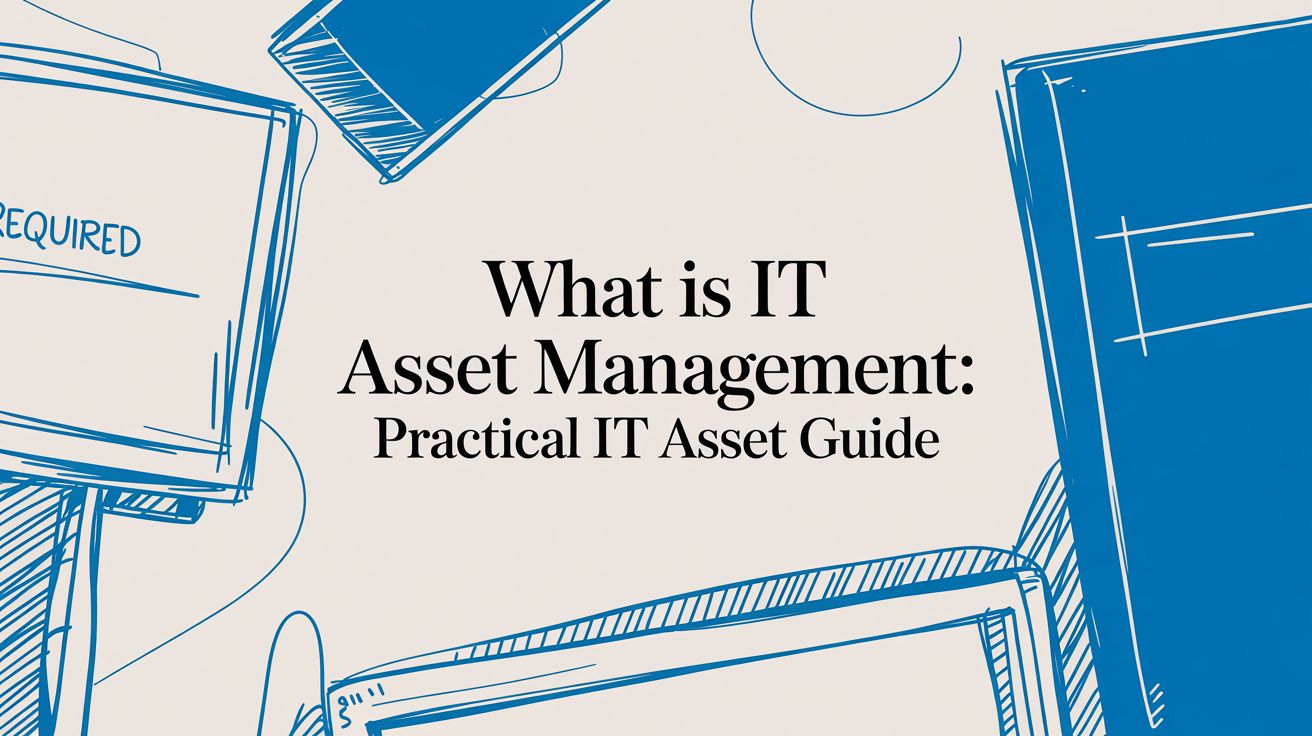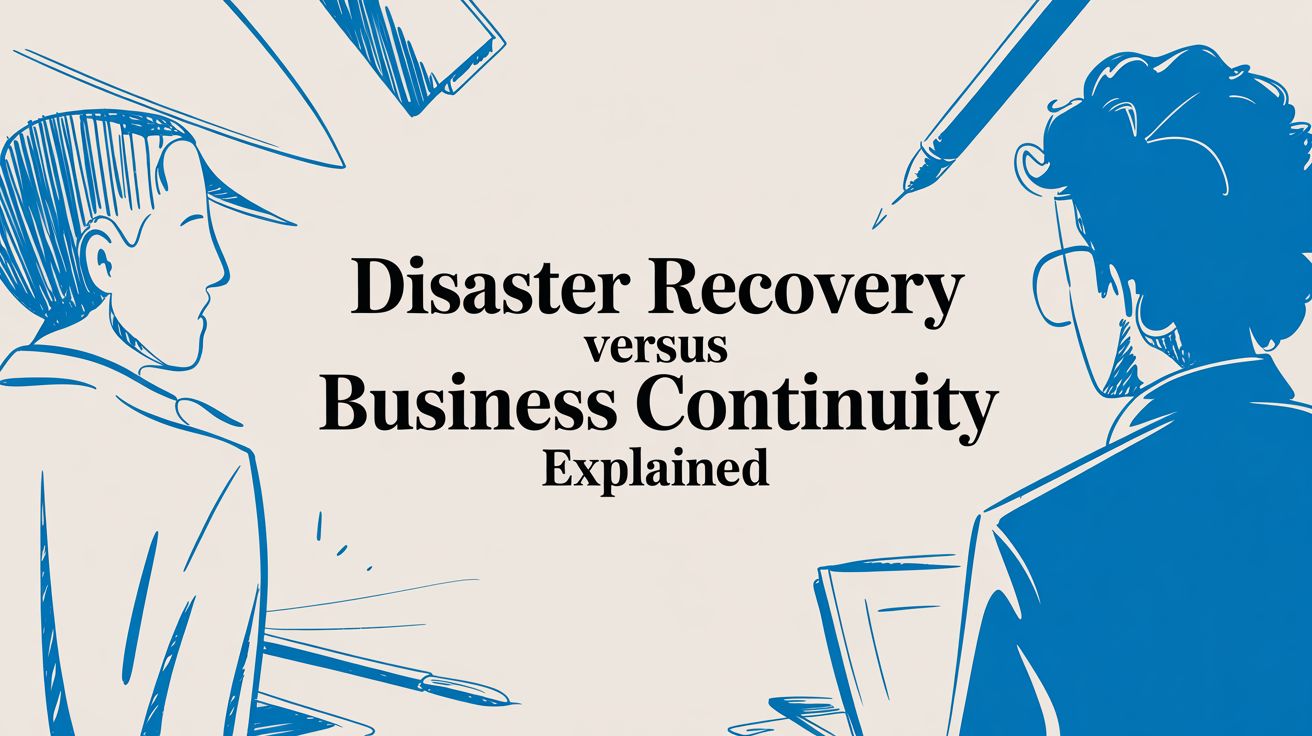Defending Your Business: A Guide to Security Threats in Network Environments
For a small or mid-sized business, security threats in network environments are more than just technical jargon—they are direct risks to your operations, data, and reputation. From automated malware scanning for vulnerabilities to targeted phishing campaigns aimed at your employees, understanding these threats is the first step toward building a resilient defense. This guide breaks down the most common threats and provides actionable steps to protect your business with a proactive IT strategy.
Why Your Network Is a Prime Target for Cybercriminals
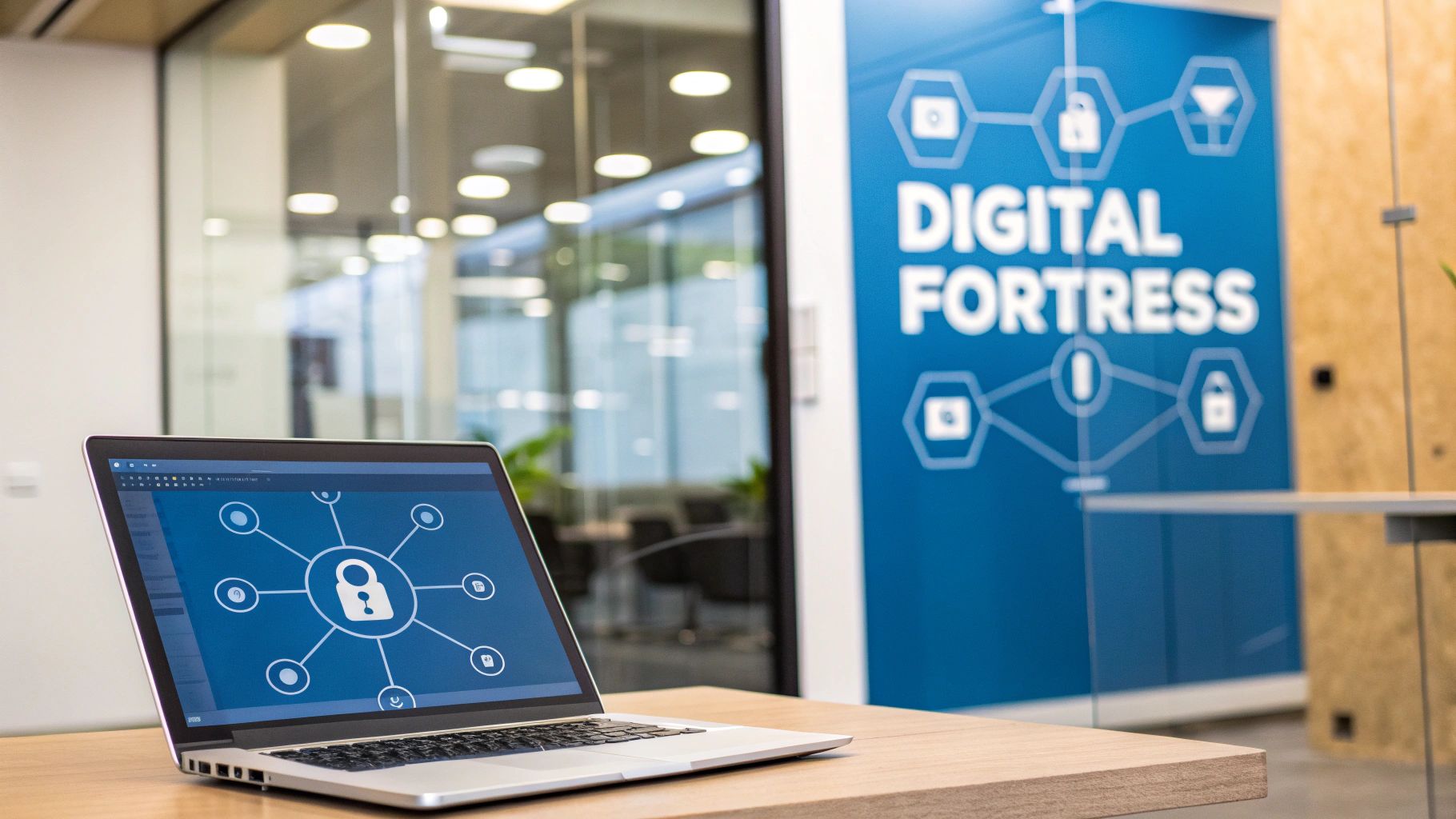
Your business network is its central nervous system, connecting employees, customers, and critical data. This connectivity, essential for modern operations, also makes it an attractive target for cybercriminals. Attackers no longer focus solely on large corporations; they use automated tools to constantly probe the internet for any sign of weakness, making any business with an online presence a potential victim.
The Staggering Financial Stakes
The scale of this problem is almost hard to comprehend. Projections show that global cybercrime damages will hit $10.5 trillion by 2025. To put that in perspective, if cybercrime were a country, it would have the world's third-largest economy.
And the pace is relentless, with an attack occurring roughly every 39 seconds. These aren't just abstract numbers; they represent a constant, real-world threat to businesses like yours.
This reality forces a major shift in thinking: cybersecurity is no longer just an IT line item. It's a fundamental business necessity. The costs of a breach—from direct financial theft to crippling downtime and a shattered reputation—dwarf the investment needed for a strong, proactive defense.
For businesses in Dallas and Memphis, a single successful attack can halt operations for days, erase client trust built over years, and result in severe financial penalties, especially if regulatory compliance is compromised. A proactive approach with a Managed IT Services partner is the most effective way to mitigate these risks.
To help you quickly understand what you're up against, here's a look at the most common threats and how they can directly impact your operations.
Common Network Threats and Their Business Impact
This table is just a snapshot, but it highlights a critical point: each threat is designed to exploit a different vulnerability with the ultimate goal of harming your business.
Moving Beyond a Reactive Mindset
The old "break-fix" approach to IT, where you only call for help after something has already gone wrong, is dangerously outdated in today's environment. Modern network security threats demand a proactive strategy—one focused on finding and closing security gaps before an attacker can get through.
This proactive defense, delivered through Managed IT Services, involves several critical layers working together:
- Continuous Monitoring: Keeping a vigilant, 24/7 watch on all network activity to spot anything suspicious the moment it happens.
- Vulnerability Management: Regularly scanning for and patching weaknesses in your software and hardware before they can be exploited.
- Layered Security: Implementing multiple lines of defense, like firewalls, endpoint protection, and smart email filtering, so if one fails, another is there to stop the attack.
- Employee Education: Training your team to be a human firewall by teaching them how to recognize and avoid common traps like phishing scams.
By getting a firm grasp on these modern threats and adopting a forward-thinking security posture, you can protect your assets and keep your business on a path to growth. To dig even deeper into these defensive strategies, you can explore our complete guide to IT security.
The Most Common Types of Network Attacks Explained
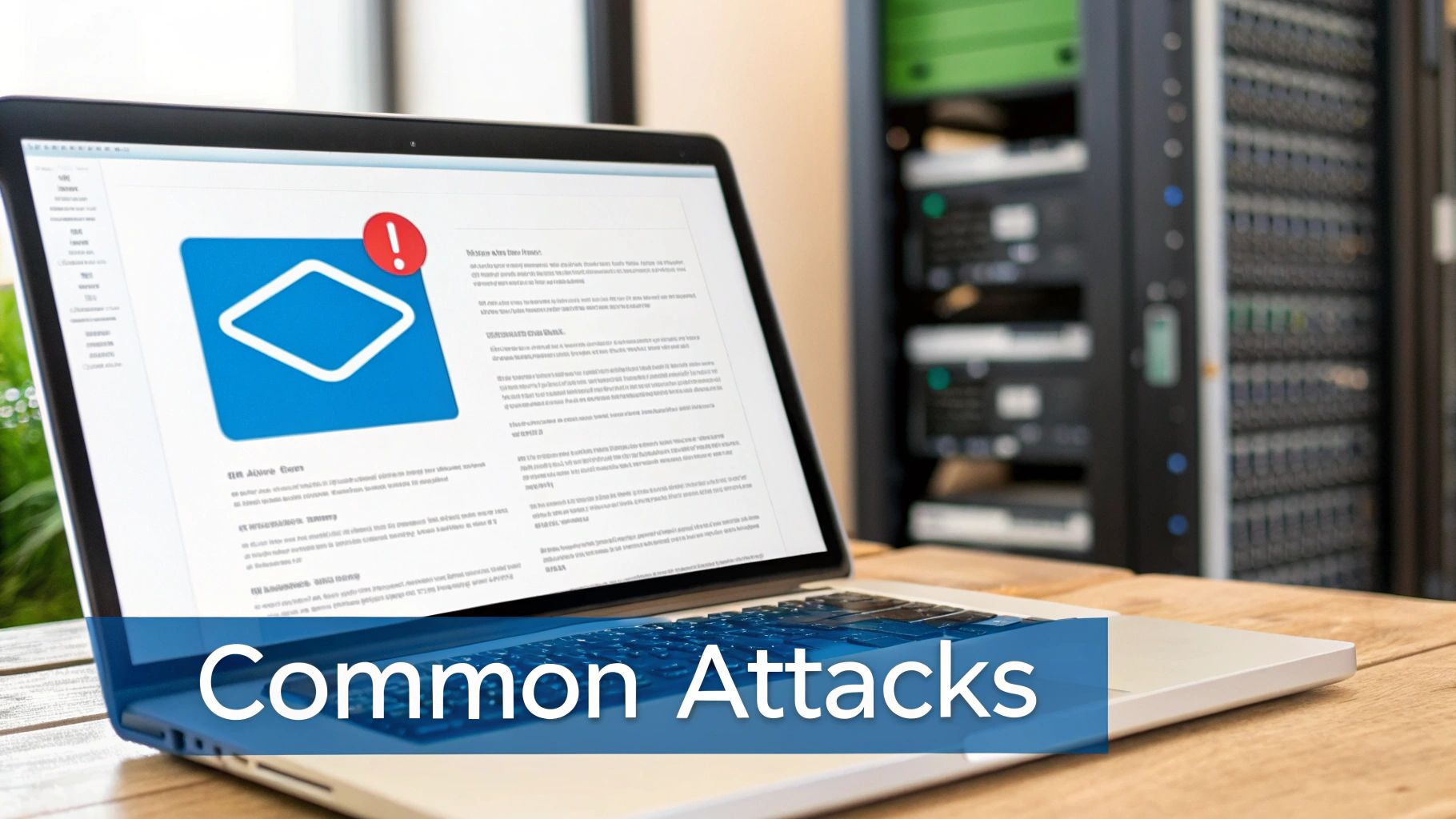
To effectively defend your network, you must understand your enemy’s playbook. Cybercriminals rely on a set of proven tactics that exploit both technology and human nature. Let's break down four of the most common security threats in network environments that every business leader needs on their radar.
Phishing: The Deceptive Email
Think of phishing as a burglar sending a fake delivery notice to trick you into leaving your front door unlocked. These attacks often arrive as official-looking emails from trusted sources—a bank, a major vendor, or even a C-level executive. The goal is to get an employee to click a malicious link or open a booby-trapped attachment.
Real-World Scenario: A Dallas-based logistics firm was crippled for a week because an employee opened a fake invoice attachment. That seemingly innocent click triggered a ransomware attack that encrypted their entire server. This outcome could have been prevented with a combination of advanced email filtering to block the threat and Security Awareness Training to help the employee recognize the scam.
Ransomware: The Digital Kidnapper
Ransomware is one of the most feared security threats in network operations today. It's the digital equivalent of a criminal locking every file cabinet in your office and demanding a hefty ransom for the keys. The attack encrypts all your data, making it completely inaccessible.
The costs go far beyond the ransom itself. The downtime can be catastrophic, grinding your business to a halt. Business Impact Example: A Memphis medical clinic without a tested disaster recovery plan was offline for ten days after a ransomware attack. They lost access to patient schedules and billing, causing massive revenue loss and reputational damage. A robust, managed data backup and disaster recovery plan is the only way to ensure you can restore operations quickly without paying the criminals.
Malware: The Hidden Saboteur
Malware is an umbrella term for any software designed to cause harm. It acts like a corporate saboteur, sneaking into your systems to spy, steal information, or disrupt operations from the inside. This broad category includes:
- Spyware: Secretly records keystrokes to steal passwords and financial information.
- Trojans: Disguise themselves as legitimate software to trick you into granting them access.
- Viruses: Infect files and then spread like a disease across your entire network.
Protecting against these threats requires modern Endpoint Detection and Response (EDR) solutions that go beyond traditional antivirus. You can get a better sense of what this looks like by exploring Endpoint Detection and Response services in Dallas.
Denial of Service Attacks: The Digital Traffic Jam
A Denial-of-Service (DoS) attack has one simple goal: to make your website or online services unavailable. A Distributed Denial-of-Service (DDoS) attack is like orchestrating a city-wide traffic jam to block every road leading to your business. Criminals use a network of hijacked computers (a "botnet") to flood your network with so much junk traffic that it gets overwhelmed and crashes. Besides these brute-force attacks, other subtle threats like malicious data scraping activities can use similar methods to steal information. The best defense is a well-managed firewall and proactive network monitoring to spot and block these disruptive attacks before they take you offline.
Why Cybercriminals Target Your Business
The myth that "we're too small to be a target" is a dangerous invitation for cybercriminals. They don't see small and mid-sized businesses as insignificant—they see them as soft targets. SMBs often handle sensitive client data and financial records but lack the fortress-like security of enterprise corporations, creating the perfect combination for a quick, profitable attack.
The Economics of Modern Cybercrime
Cybercrime has become an incredibly efficient business. Attackers use automated tools that scan the internet 24/7, relentlessly probing for any unpatched software, weak password, or misconfigured firewall. Your business isn't being personally singled out by a lone hacker; it's being continuously tested by bots looking for an easy way in.
It's a numbers game. Breaching hundreds of smaller networks can be just as lucrative—and far less difficult—than trying to crack one heavily fortified enterprise. This automated approach means every single business with an internet connection is in the line of fire.
An attack isn't just about stealing your data. It's about crippling your operations, destroying your reputation, and even using your network as a launchpad for other attacks. This is why proactive security isn't just another expense; it's a direct investment in your company's survival.
You Are Part of a Larger Ecosystem
Criminals know that no business operates in a vacuum. You're connected to vendors, partners, and clients, and this interconnectedness creates a huge risk: the supply chain attack.
An attacker might target a local Memphis accounting firm, not for its own data, but because it serves much larger corporate clients. By breaching the smaller, less-secure firm, the criminal gains a trusted backdoor into the networks of their real, high-value targets. Your business becomes an unwilling key to someone else's digital kingdom. This is why a basic security setup just isn't enough. The complex nature of modern security threats in network environments demands a strategic, multi-layered defense. To level the playing field, many businesses explore the benefits of outsourced IT support, bringing in specialized expertise to protect their operations and critical connections.
Building Your Resilient Defense with Managed IT
Knowing the threats is just the starting line. The real win comes from building a defense so solid that attackers give up and move on. This means leaving the old break-fix IT model behind for good.
Partnering with a Managed IT Services provider helps you build that defense—a smart, multi-layered shield that doesn't just react to problems but actively prevents them. It's about turning technical tools into real-world business protection. For instance, a managed firewall isn't just a box with blinking lights; it's a vigilant digital gatekeeper, inspecting all data to block malicious traffic. Endpoint Detection and Response (EDR) acts like a 24/7 security team on every device, spotting suspicious behavior that old-school antivirus would miss.
From Reactive Fixes to Proactive Prevention
The core of a strong managed defense is preventing problems before they start. Instead of scrambling after a breach, this approach is all about sealing the cracks before an intruder can exploit them.
One of the cornerstones is automated patch management. This is the digital equivalent of a maintenance crew that instantly repairs any newfound vulnerability in your software, fixing a broken window the moment it cracks. Constant network monitoring adds another crucial layer, allowing experts to spot unusual activity and potential intrusions in real-time. This shift from reaction to prevention is what modern cybersecurity is all about. To get a better sense of the tools involved, check out this guide on essential security solutions for businesses.
A Real-World Example of Proactive Defense
Consider a Dallas-based property management firm stuck in a cycle of IT issues and constant worry about their data. After partnering with a Managed Services Provider (MSP), they implemented a full suite of proactive defenses. Not long after, a clever phishing email bypassed their basic filters. When an employee clicked the link, the EDR solution on their computer instantly detected the malicious script. The system quarantined the device from the network, stopping the attack in its tracks while alerting the security team.
The incident was neutralized in minutes. No data was lost, and business never stopped. This outcome was only possible because a proactive, layered system was already standing guard, turning a potential disaster into a non-event.
This infographic breaks down how cybercriminals often work their way into a business, usually by finding the path of least resistance.
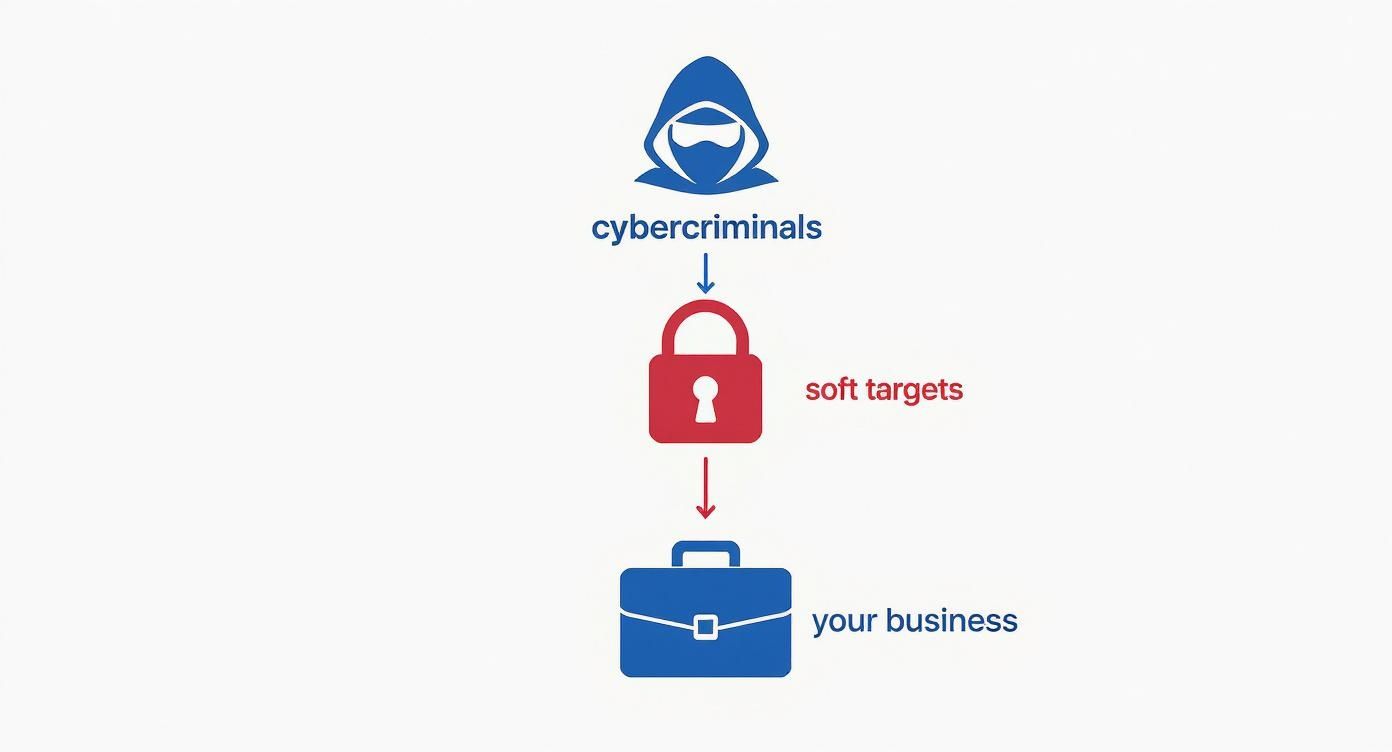
As you can see, attackers often go after the "soft targets" first. When those foundational weaknesses are left open, it’s only a matter of time before they reach their ultimate goal: your business.
Recent research into global cyberattacks backs this up. A shocking 45% of incidents took advantage of external remote services, and another 18% hit public-facing applications. These aren't random attacks; they're targeted strikes against common weak points that a managed, proactive strategy is designed to fix. By combining around-the-clock monitoring, automated maintenance, and advanced security tools, a managed IT partner delivers a comprehensive security strategy that makes your technology a secure asset, not a liability.
Your Team Is the First Line of Defense
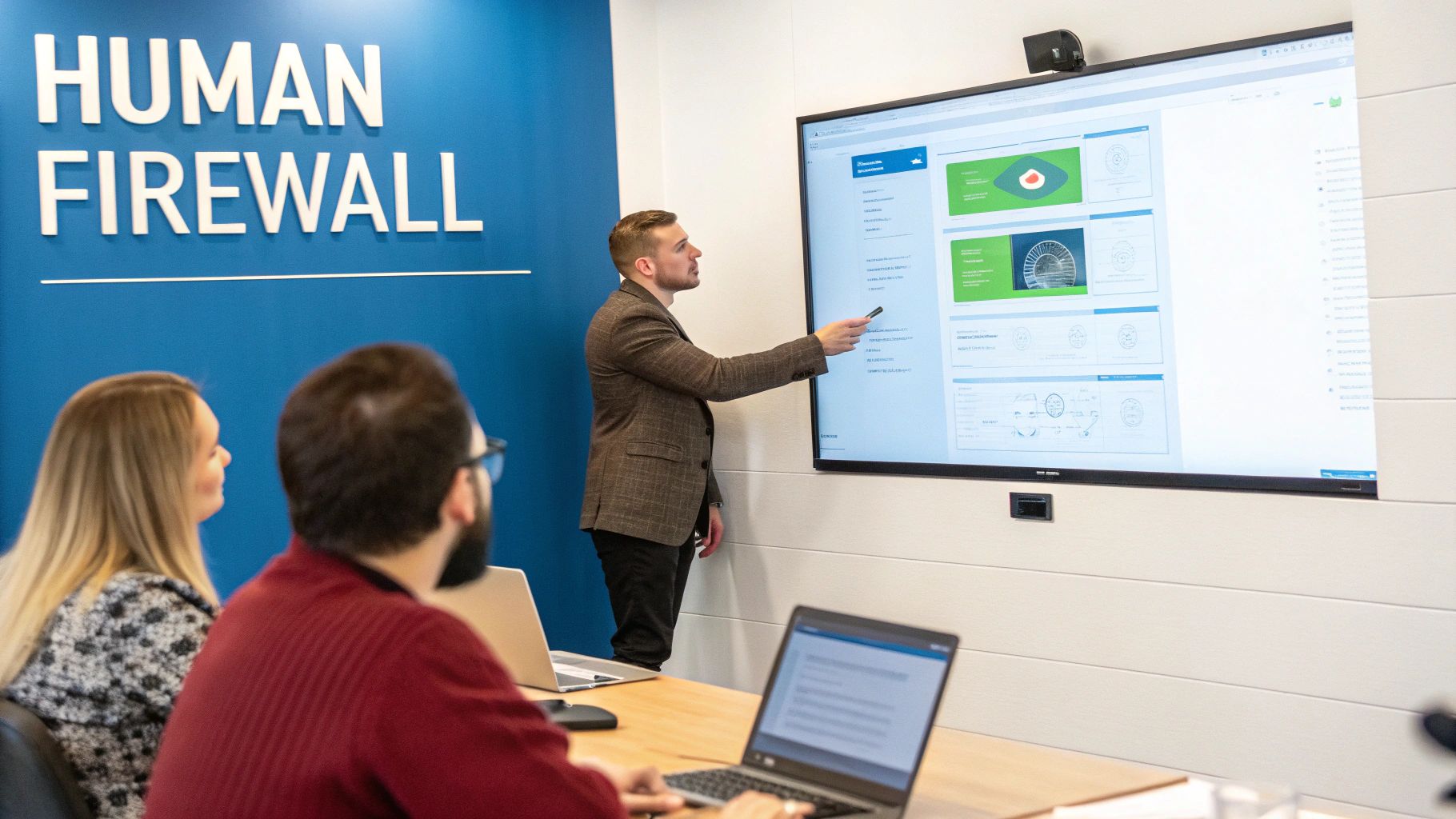
While firewalls and antivirus software are essential, they only go so far. Your strongest security asset isn't a piece of technology; it's your employees. Cybercriminals know this all too well—it's often easier to trick someone into opening a door than to break it down. This simple truth reframes how we should view security threats in a network. It means your team can either be your most vulnerable point or your most powerful shield. The difference comes down to consistent, practical Security Awareness Training.
Turning Employees into a Human Firewall
Effective training isn't a one-off presentation. It’s about building a genuine culture of security. This starts by teaching employees how cybercriminals operate, particularly their use of social engineering—the psychological manipulation used to trick people into divulging information or taking harmful actions. Attackers create a false sense of urgency, impersonate trusted figures, and play on human emotions to get people to act without thinking. A well-designed training program gives your team the tools to spot these tactics.
Here's what that looks like in practice:
- Phishing Simulations: Sending your team safe, simulated phishing emails provides real-world practice for spotting suspicious links without any actual risk.
- Regular Micro-Learning: Short, engaging lessons on topics like creating strong passwords, identifying scam phone calls, and staying safe while working remotely are more effective than an annual data dump.
- Clear Reporting Procedures: Making it simple and blame-free for employees to report anything suspicious empowers them to speak up and provides your IT team with an invaluable early warning.
An employee who reports a suspicious email—even one they accidentally clicked—is a huge security asset. That single report can be the first domino that stops a full-blown attack before it even starts.
The Real-World ROI of Security Training
The return on this training is direct and measurable. Client Scenario: A Memphis-based professional services firm was dealing with a high number of employees clicking on risky email links. After implementing a managed security awareness program with regular phishing tests and training modules, they saw a 78% reduction in risky clicks in just six months.
That's not just a number. It's a dramatic drop in risk that prevented multiple potential breaches, protected their sensitive data, and saved them from the staggering costs of downtime and recovery. It’s a perfect example of how investing in your people's security skills pays for itself many times over. To learn more about building this human firewall, see how a structured Security Awareness Training program in Dallas can fortify your defenses from the inside out.
Answering Your Network Security Questions
Getting your arms around network security can feel overwhelming. Breaking it down into core issues is the best way to start building a real defense. Let's tackle some of the most common questions business owners ask about keeping their digital world safe.
What Is the Single Biggest Security Threat to My Small Business Network?
While ransomware gets the headlines, the threat that consistently does the most damage is human error exploited by phishing attacks. It only takes one employee clicking one bad link to open the doors for an intruder, rendering expensive firewalls useless. A solid security plan must fight the battle on two fronts:
- Smarter Technology: This includes intelligent email filtering to catch malicious messages and endpoint protection to block threats automatically.
- Smarter People: This means ongoing Security Awareness Training that teaches your team how to spot and report suspicious activity.
A Managed IT Service provider integrates technology and training into a multi-layered defense that addresses both machine and human vulnerabilities.
Is Antivirus Software Enough to Protect My Network?
Absolutely not. Traditional antivirus is a necessary first step, but it's completely outmatched by today's sophisticated threats. Modern security threats in network environments are designed specifically to bypass old-school signature-based antivirus. Think of it like a security guard with an outdated list of known troublemakers; anyone new can walk right in.
An effective defense needs multiple layers working together, including:
- A managed firewall to act as the gatekeeper for your network.
- Email security to stop phishing attempts at the source.
- Consistent software patching to seal up known security holes.
- Endpoint Detection and Response (EDR) to actively hunt for signs of a breach.
EDR is like a modern surveillance system watching for suspicious behavior, ready to neutralize attacks that a simple antivirus program would never see. This complete security stack is the bedrock of modern managed cybersecurity services.
How Do I Protect My Business with a Remote Workforce?
Securing a remote team means extending your company's security perimeter to cover every employee's location. Every home office in Dallas or Memphis is now an entry point you must defend. The goal is to ensure an employee working from a coffee shop is just as secure as one in the main office.
Protecting a distributed team isn't just about technology; it's about applying consistent security policies everywhere. This is a core component of modern cloud and remote support solutions offered by MSPs.
Key strategies include:
- Virtual Private Network (VPN): Creates a secure, encrypted tunnel for all internet traffic between an employee's device and the company network.
- Multi-Factor Authentication (MFA): Stops a hacker even if they've stolen a password by requiring a second form of verification.
- Centralized Endpoint Management: Ensures every device—laptop, tablet, or phone—has the right security software, is always up-to-date, and is monitored for threats.
A Managed IT Services provider can implement and manage these tools, ensuring every connection to your network is secure, compliant, and productive.
Don't let network security threats dictate your business's future. PWR Technologies provides proactive, enterprise-grade IT management and cybersecurity to keep your Dallas and Memphis operations safe and running smoothly. Secure your free consultation today.


